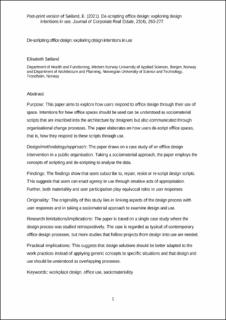| dc.contributor.author | Søiland, Elisabeth | |
| dc.date.accessioned | 2022-03-07T13:35:45Z | |
| dc.date.available | 2022-03-07T13:35:45Z | |
| dc.date.created | 2021-11-12T11:06:39Z | |
| dc.date.issued | 2021 | |
| dc.identifier.citation | Søiland, E. (2021). De-scripting office design: exploring design intentions in use. Journal of Corporate Real Estate, 23(4), 263-277. | en_US |
| dc.identifier.issn | 1463-001X | |
| dc.identifier.uri | https://hdl.handle.net/11250/2983471 | |
| dc.description | This author accepted manuscript is deposited under a Creative Commons Attribution Non-commercial 4.0 International (CC BY-NC) licence. This means that anyone may distribute, adapt, and build upon the work for non-commercial purposes, subject to full attribution. If you wish to use this manuscript for commercial purposes, please contact permissions@emerald.com | en_US |
| dc.description.abstract | Purpose
This paper aims to explore how users respond to office design through their use of space. Intentions for how office spaces should be used can be not only understood as sociomaterial scripts that are inscribed into the architecture by designers but also communicated through organisational change processes. The paper elaborates on how users de-script office spaces, that is, how they respond to these scripts through use.
Design/methodology/approach
The paper draws on a case study of an office design intervention in a public organisation. Taking a sociomaterial approach, the paper uses the concepts of scripting and de-scripting to analyse the data.
Findings
The findings show that users subscribe to, repair, resist or re-script design scripts. This suggests that users can enact agency in use through creative acts of appropriation. Further, both materiality and user participation play equivocal roles in user responses.
Research limitations/implications
The paper is based on a single case study where the design process was studied retrospectively. The case is regarded as typical of contemporary office design processes, but more studies that follow projects from design into use are needed.
Practical implications
This suggests that design solutions should be better adapted to the work practices instead of applying generic concepts to specific situations and that design and use should be understood as overlapping processes.
Originality/value
The originality of this study lies in linking aspects of the design process with user responses and in taking a sociomaterial approach to examine design and use. | en_US |
| dc.language.iso | eng | en_US |
| dc.publisher | Emerald | en_US |
| dc.rights | Navngivelse-Ikkekommersiell 4.0 Internasjonal | * |
| dc.rights.uri | http://creativecommons.org/licenses/by-nc/4.0/deed.no | * |
| dc.subject | scripting | en_US |
| dc.subject | workplace design | en_US |
| dc.subject | sociomateriality | en_US |
| dc.subject | office use | en_US |
| dc.subject | user practices | en_US |
| dc.subject | user responses | en_US |
| dc.title | De-scripting office design: exploring design intentions in use | en_US |
| dc.type | Peer reviewed | en_US |
| dc.type | Journal article | en_US |
| dc.description.version | acceptedVersion | en_US |
| dc.source.pagenumber | 263-277 | en_US |
| dc.source.volume | 23 | en_US |
| dc.source.journal | Journal of Corporate Real Estate | en_US |
| dc.source.issue | 4 | en_US |
| dc.identifier.doi | 10.1108/JCRE-10-2020-0039 | |
| dc.identifier.cristin | 1953995 | |
| cristin.ispublished | true | |
| cristin.fulltext | postprint | |
| cristin.qualitycode | 1 | |

